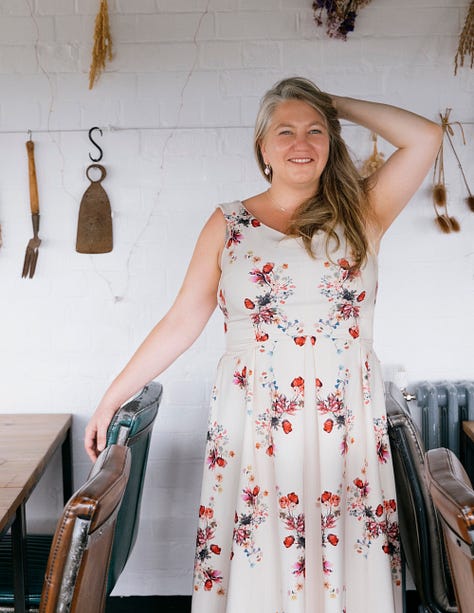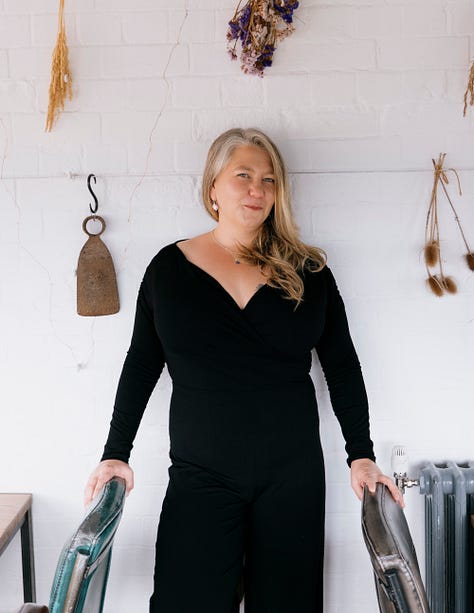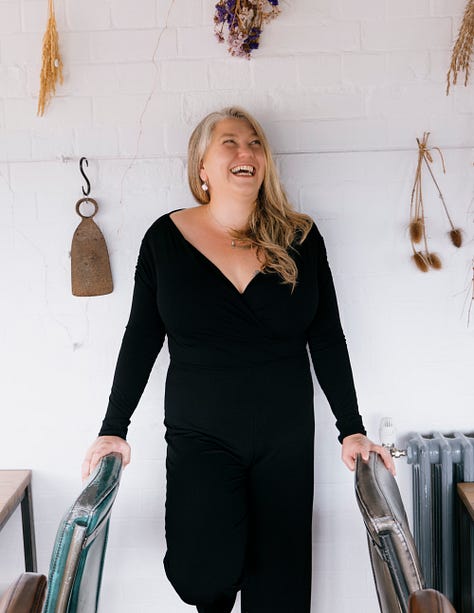I’ve been thinking about restaurant reviews.
What are they good for?
Have we outgrown them?
Does anyone care when the world is in crisis?
Rosio Sanchez at Hija de Sanchez
When I was a youth, I used to love the weekend magazines. My parents would have the papers delivered, and I’d furtively steal the shiny inserts, disappearing them away before my father could notice they’d gone.
I’d read through Guardian Weekend, feeling grown-up and sophisticated. Rapidly flicking past anything I considered to be ‘boring,’ hungrily on the lookout for my favourite column - the restaurant review.
Nigel Slater or Jay Rayner would be eagerly inhaled, as they described their latest culinary expedition. Intriguing explanations of an unknown dish or ingredient. Some witheringly, pithy critique. The genuinely chuffed moments when they discovered a spot with ‘potential’, or when a chef surpassed expectations to reach that pinnacle of ‘the sublime.’
I could almost hear the low murmur of contented diners, the clink of polished glass, the bustle of attentive service. They tempted me with a sly glimpse of something far removed from the culinary offerings of Sheffield in the late ‘90s.
We had The Flying Pizza - that particularly British, old-school Italian, where wax layered in drips down the side of rattan-covered wine bottles, and someone once got mysteriously shot in the carpark.
The crescendo of my weekend reading was the Observer Food Monthly. Available once a month (the clue is in the name), I would eagerly await its arrival. A whole magazine dedicated to food and restaurants, and wine. Chefs photographed like they were rockstars. Farmers upheld as superheroes. It was aspirational.
These publications offered me a window into a whole new world. An intriguing sort of something, which caught at the edges of my imagination. A route out, perhaps? A roadmap towards...
Without them, I might never have become a waitress at fifteen, might never have fallen in love with food, might never ended up in Italy for University. Their writing sowed the early seeds of my career.
Staff Meal at Osteria Francescana
The glory days of a few weighty print publications are firmly behind us, however. And along with them, some of the power and influence held by their guardians and gatekeepers. Whilst this is objectively a good thing, food writing, or more accurately, food-related-content-creation has ostensibly tipped in the opposite direction.
At its best, this means the democratisation of access and inclusion. A plethora of new voices have broken through. Where previously, we heard only from those that editors or publishers deemed worthy, now we can experience a host of differing opinions. Many of them are women, choosing to occupy space without waiting for permission.
Some of my favourites (new & established) include Alicia Kennedy, Dr Julia Skinner and Malika Basu. I am in awe of the American writer, Elissa Altman, who manages multiple posts each week, yet achieves both depth and accessibility in her writing.
The Riverford Magazine, Wicked Leeks, has gone from strength-to-strength under editor, Nina Pullman. With Guardian journalists, such as Felicity Cloake, contributing pieces like on food and class, in-part presumably, because mainstream editors still struggle to commission anything that doesn’t appeal to a distinctly beige middle-ground.
The common denominator is that each is approaching food writing with some guts. Unafraid to tackle complexity or nuance. They view food as an issue of culture, economics, politics and diversity. Moving beyond the twee or inane. Sharing recipes, yes, but almost always in service to some deeper culinary context.
In the interest of balance, it’s not only women claiming some space.
I find Thom Eagle’s from leaf/notes curiously engaging. Split into brief sections, like ‘in the soil’, or ‘on the page,’ it feels more private diary than public newsletter. Snippets of a culinary life through the lens of Thom’s brain. Testament to finding beauty in the smallest of things.
If wine writing is your vibe, I’ve been enjoying Everyday Drinking by Jason Wilson. I only recently discovered him via Substack, and find his newsletter brilliantly accessible, non-stuffy and positively educational.
Food and drink writing has been enjoying an overdue burst of evolutional development for a while now. There are more of us wading around, unafraid to pose questions that we might not have all the answers to.
But what of the restaurant review? Whilst new food writing is to be found in abundance, a surprisingly small amount, it feels, is specifically focused on developing our thinking about restaurants. Not whether the food they cook is subjectively good or bad on any given day. But, what are they? Who are they for? To what extent are they engaged in their local communities? How are they coping? And how can you tell?
In some ways, it feels easier to define what I’m not…
I’m not aiming to be publish weekly restaurant reviews.
If that’s your thing, then Vittles Magazine have done an amazing job of highlighting the lesser known in London. In Bristol, Just Meg is your girl for great food hidden on an unassuming council estate, or a deep dive into the latest new opening. Up in Manchester, I’ve been enjoying Kel is Eating (even though I know little about Manchester’s food scene and often have no clue who she’s talking about.)
Nobody can recommend good food better than the locals, and these guys have got you covered.
A recent brunch dish at Poco Tapas Bar in Bristol
An opening, it seems to me, is about the worst possible time to get a clear idea of what consistent quality from a restaurant might look like.
What is there to say? Other than, yay! This place is new. Maybe you want to go?
Over the summer, I observed one Bristol spot launch a new menu, for a star-studded crowd of our city’s mightiest influencers.Instagram would have you believe it was the hottest spot in town. But, I couldn’t help noticing that the food looked mediocre, and that it felt unfair to other, potentially better, restaurants that don’t enjoy the same ability to curate a crowd with social media reach.
It’s the in-between spaces I’ve become interested in. The gaps between what a chef says - particularly online and in the media - versus the reality of what they’re delivering.
If you’re serving one single scallop for £19, for example, then how are you justifying that price? Is it the best god-damned scallop I’ve ever eaten? Will it blow me away to such an extent that I can begin to understand how it might justify its £19 price-tag? Maybe. Possibly...
In a way, I kind of hope so. A part of me would love to write that it does. I’d like to consume that very expensive morsel and in doing so, understand the why.
Make no mistake about it. I am, unapologetically, one of those ‘social gastronomy’ knobs. I fundamentally believe in the power of food to transform lives. And I’m genuinely sorry to bang on about how a meal can be a perspective shifting, life altering, transcendental sort of experience, but the truth is… it absolutely can be.
I believe in meals, restaurants and chefs as potential vehicles for delivering a sensorially significant impact on our bodies and minds. They hold the power to physically disrupt the boundaries of what we thought was possible.
At the risk of sounding wanky and esoteric, I know there are meals as good as a masterpiece, as rich as a symphony, as mind opening as… you get my drift. I know it to be true, because I’ve experienced it.
The first time I was ever presented with Salsicca di Bra - a raw veal sausage, and a speciality of the small Italian town where I studied - it was not a positive experience. I would love to claim that I wolfed down this regional speciality with enthusiasm and gastronomic delight. But in reality, I smiled politely, while trying not to be a little sick in my mouth. Within weeks however, it was our favourite snack. My daughter would skip out of the butcher’s shop, contently sucking on the piece of raw meat she’d been gifted.
There was a chicken supreme, eaten in the cantina of French biodynamic wine-maker, M.Chapoutier. I remember feeling overwhelmed with delight. The kind of happy where you have to pause and look around yourself. It was less to do with the chicken, and more because I’d never had food or community like this before. This was my life now, and that blew my mind.
Then there was the Scottish chef, who once convinced me to jump on a train from a film festival in Amsterdam to somewhere near the Belgian border. We ate 3* food by Johnny Boer in the basement of a 17th century monastery. Sitting at the chefs table, I remember a kombucha-poached langoustine with lemon verbena cream, above all else. To this day, it remains one of the sexiest morsels I’ve ever put in my mouth.
Do these memories stick because of the outstanding quality of the dining experience? Possibly. But mostly, I think, the meals we remember are a much more complicated mix of place, time, people, and how hungry you were when you sat down.
It’s the moments of delight or disgust that make an impression. Those tastes which, once consumed, hit your palette with such a perspective altering sense of what’s possible that a laugh, gasp or giggle escapes your lips. It’s something you have no control over, and often can’t find words to describe.
It feels odd to be writing about culinary delight in the context of everything going on in the world. Most days, I ponder what future our restaurants have at all, as the cost of living bites and our supply chains become increasingly destabilised by the climate crisis.
To write about joy feels a bit audacious. Maybe that’s exactly why it’s necessary.
For me, it’s about equality of access. Who gets to eat in these spaces? How can culinary experience transform perception? How do we deliver connection with nature, the seasons and our food producers, and how do we go about democratising inclusion?
What role, if any, can the restaurant review play in influencing change? Can we consider the role of restaurants as so much more than simply another product to be consumed?
I’ve had some ideas, which I hope might go beyond the individually subjective. Something more call and response. A bit less finite. A starting point for a conversation, rather than the full stop at the end of it.
A couple of brave chefs have agreed to let me use them for some lab tests. Let’s see what comes out.











Thank you so much for your kind words. Having spent some time as a restaurant reviewer -- for me it was an absolutely dismal job, a horror show for the most part -- I am in awe of people who do it well (like Marina, and back in the early 2000s, Amanda Hesser in the States). For me, the culinary experience is so subjective, and some of the best meals I had in that role were in tiny places with tiny kitchens. I’m someone who prefers a bowl of jook to a vertically plated sliver of Guinea fowl dipped in kumquat juice, so fancy is a hard sell for me. Although I loved my meal at Osteria Francescana a decade ago. Still remember it well!
"oh so you review restaurants then". Usually the response when you tell someone you're a food writer. In my case, it's not an inaccurate comment, but I'm loath to be that person who decrees what's good and what's not. Like Vittles, can we have more essays/explorative pieces on restaurants, thier stories, and the contexts in which they reside? Articles that tell us more about the why, and who, and how (thus doing more to show us why a venue is worth trying out, rather than tellling us so)?